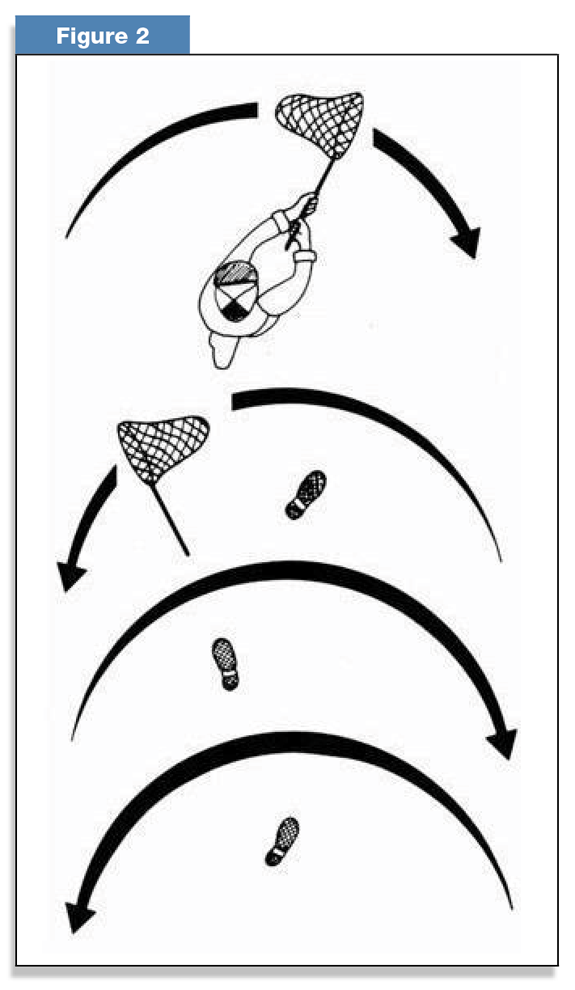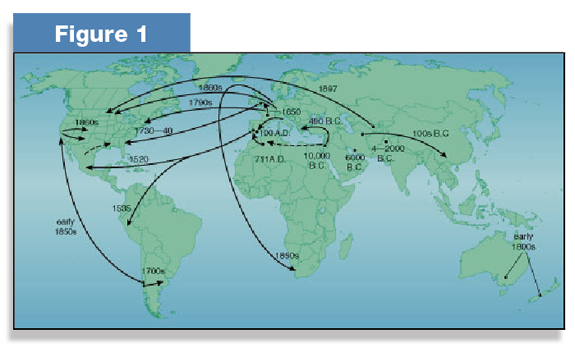Since then, it has been cultivated throughout the world, becoming important in Europe, Australia, South America, South Africa, China and the Middle East (Figure 1).
Alfalfa was first introduced into the U.S. from Chile in 1850, with the U.S. becoming the largest producer of forage alfalfa in the world.
Alfalfa is grown both for seed and forage, and is a perennial crop that is preferred feed for thoroughbred horses, dairy cows and other livestock. Alfalfa use as a perennial crop makes it the ideal environment to foster population development of both beneficial and pest insects alike.
Large numbers of natural enemies can be found in alfalfa including lady-bird beetles, Green lacewings, bigeyed bugs (Geocoris spp.), damsel bugs (Nabis spp.), syrphid flies, as well as numerous parasitic wasps. In fact, a healthy alfalfa crop with a diverse array of natural enemies may be able to suppress pest populations (i.e. aphids) to non-economic levels.
Fostering the use of natural enemies as part of an integrated pest management (IPM) program would allow alfalfa growers to better manage pest outbreaks. The use of IPM tactics also include the use of biological control, modifications of cutting schedules, the use of strip or border cutting, resistant varieties and pesticides when required.
1. Proper identification
The cornerstone of IPM is knowledge of the pests attacking a crop and an understanding of the relationship of density of those pests to crop damage.
Properly identify insects when sampling in the alfalfa field. Many insect species, particularly in the immature stages, are similar in appearance and may be easily confused with one another.
For example, Lygus nymphs may be confused with bigeyed bug nymphs, a generalist predator. The blue alfalfa aphid and pea aphid appear similar and can only be distinguished with a careful examination of the aphid antennae with a hand lens.
Because economic treatment thresholds differ for specific pests, improper identification can lead to improper management decisions.
Likewise, failure to properly identify natural enemy species may lead to unnecessary pesticide applications if natural enemy populations are sufficient to maintain pest numbers below economic treatment levels. It is important that the scouting program include not only an assessment of the pests present but also the natural enemies, including the specific life stages.
2. Routine field sampling
Regular scouting of alfalfa fields is necessary to determine pest density and upon establishment of densities when treatment is warranted, i.e. the use of thresholds.
The action threshold is defined as the level(s) of pest populations at which some type of control action should be implemented to avoid significant damage to the crop. Action thresholds help determine both the need for control actions and the proper timing of such actions and may take into account the relative density and distribution of pests, but also the stage of growth of the plant.
3. How to monitor
The use of efficient sampling methods is necessary when scouting alfalfa fields due to the large area you may have to cover. The sampling method(s) used depends on the insects you wish to evaluate.
The most common sampling method used in alfalfa is with a 15-inch-diameter sweep net. How you use the sweep net can greatly influence its effectiveness for collecting insects in alfalfa and, consequently, treatment decisions based on the number of insects caught. Therefore, standard methods have been developed for sampling so results from different individuals are comparable.

To use a sweep net, swing it in a 180° arc so that the rim of the net strikes the top 6 to 8 inches of alfalfa growth. Hold the net slightly less than vertical so the bottom edge strikes the alfalfa before the top edge. This will facilitate getting the insects into the net. Each 180° arc from side to side counts as one sweep (Figure 2).
A common practice is to sweep from right to left, walk a step and take another sweep, left to right. After taking the desired 10 sweeps at each location, quickly pull the net through the air to force all insects into the bottom of the net bag and grasp the net bag with a hand at about the mid-point.
Count the insects of interest and divide totals by 10 to get the average number of insects per sweep. To get a good representation of insect numbers in the alfalfa field, take sweep net samples in four different areas of the field. Refer to University of California – Davis IPM website for specific sweep net sampling guidelines for each pest.
For shorter regrowth alfalfa, do not rely on sweep net sampling to determine population levels. Instead, examine plant stems for insects and recently damaged foliage. Randomly choose five stems from each of four areas per field, noting if the average plant height is less than 10 inches, 10 to 20 inches or more than 20 inches. Place each stem sample over a white pan and tap; this will dislodge the insects into the pan, which can then be assessed.
Yellow sticky traps can also be used for estimating relative densities of flying insects and has been shown to trap significantly more insects such as lady-bird beetles, than sweeps or stem counts, and is most useful in determining changes in adult densities over time.
4. Proper pesticide selection
A problem for growers attempting to implement an IPM program in alfalfa is the lack of information regarding the compatibility of insecticides with natural enemies.
It is necessary to evaluate the relative toxicity of selected pesticides to natural enemies, which include the parasites and predators of aphids, lepidoptera and Egyptian alfalfa weevil.
Some pesticides are highly toxic to some life stages of natural enemies, but not all. Broad-spectrum insecticides like carbaryl should be avoided since it is highly toxic to all life stages of natural enemies when compared to Bacillus thuringiensis and cyromazine, which are relatively non-toxic to all life stages of all natural enemies.
Conservation of natural enemies through the use of timed applications of selective insecticides for targeted pest management cannot only be feasible, but can be a reality.
Summary
• Proper identification
o Know what you are looking at.
• Routine field sampling
o Sample your field to spot trouble before it starts and be aware of the presence/absence of natural enemies.
• How to monitor
o Know the best way to monitor for the insects you are looking for and spray only when populations have exceeded threshold.
• Proper pesticide selection
o Limit season-long pesticide selection pressure and choose an insecticide that conserves natural enemies and does not make the pest situation worse.
o Rotate insecticide chemistry classes and/or modes of action. FG
Vonny M. Barlow
Farm Advisor
University of California








